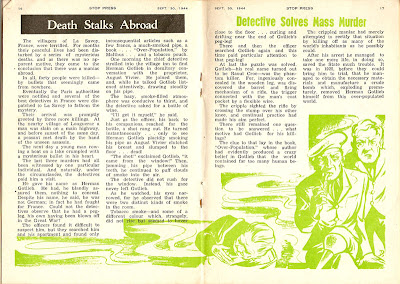It Happened in New Zealand was a newspaper feature produced by artist, writer, and historian Ross Gore in the 1950's. Combining illustration, text and word balloons Gore detailed historical events and mysteries from pre-european times through the European colonisation of New Zealand. Many of Gore's strips focused on clashes during the Maori Wars as well as myth and folklore. Some stories were adapted from accounts related to Gore such as the tale of sailor Albert Roberts who was pronounced dead during the seven months he spent missing presumed drowned whilst shipwrecked on a rock several miles from Auckland in 1907.
Gore's father Henry Morland Gore (1864-1930) painted landscapes and served eight years as President of the New Zealand Academy of Fine Arts. Gore's brother Eru Digby Gore (1906-1947)
was a land agent and Secretary-Manager of the National Art Gallery in Wellington. Gore's daughter Jenny Gibbs recalls Gore carrying a sketchbook all his life, drawing and painting wherever they went – family holidays in their old army tent and family picnics up rivers.
Unexplained mysteries were a feature of Gore's work with tales of mysterious artifacts, premonitions, and hidden treasures.
It Happened in New Zealand was featured in many papers all over New Zealand. The Evening Post, The Auckland Star, The Christchurch Star-Sun, The Taranaki Herald, The Southern Cross, The Greymouth Evening Star, The Southland Daily news and The Students Digest all carried it at a time. The Students Digest published a collection of 48 strips in 1953. Atypical of other newspaper features of the time Gore attributed copyright to himself or the person who's story he was adapting in the bottom right corner of each strip.
A second collection of 30 strips, Thrilling Tales of Rotorua was
published in 1958 by Wellington publisher A.H. & A. W. Reed.
As well as the 78 strips featured in the two collections at least another 130 were completed. 208 original pages of Ross Gore's cartoons were donated by Gore's daughter Jenny Gibbs to the cartoon archive at the Alexander Turnbull Library in 1995. Gore worked at just over double up size with his six panel strips being reproduced at 14.5cm by 21cm in contrast to his originals that typically had a working area of 31cm by 53 cm.
Stop Press was a 32 page digest of stories and cartoons produced during the 1940's by Wellington publisher, Mcdonald Publications. Typical of the era there are no authors or artist's credited short of the occasional artist's signature. Patsy Kane was a one page comic serial in the vein of Norman Pett's Jane launched in England twelve years prior. Like Jane Patsy Kane becomes involved in intrigue whilst spending a portion of each episode scantily clad or nude.
Patsy Kane has no artist credit but I theorise it may be the work of Ross Gore. In the August 12 1944 episode above Patsy meets a man by the name of 'Ross Gawe'. This could have been a subtle way of Gore 'signing' his work.
The episode below features a 'D' in the bottom last panel which again could be Gore's masked way of signing his work by using the initial of his middle name.
The illustration below from the same issue of Stop Press is signed the same and is very similar stylistically with the work of Gore's It Happened in New Zealand strips.
In the episode below Ross Gawe is revealed to be a villain. Another possible theory is this comic is the work of an acquaintance of Gore who has named his villain after Gore as a prank. it's not unknown for cartoonists to slip their colleagues into their work.
The Stop Press digests feature adverts for Auckland publisher Jaycol Comics including Victory Feature Comic that is clearly the work of the same artist as Patsy Kane, referred to by New Zealand comic enthusiast's Tim Bollinger and Geoff Harrison as 'The Baby Face Artist' on account of all his characters having similar features.
The same artist illustrated the lead story in Meteor Comics, a fourteen page Flash Gordon-esque Sci-fi adventure. None of these comics feature artist credits or dates but it is probable they were published in the mid 1940's with Victory Feature Comic likely appearing around the time it was advertised in Stop Press late 1944.
It is possible Ross Gore is one of the pioneering figures in New Zealand comics. There is no conclusive evidence but hopefully more information will surface.
Sources: http://www.nzetc.org/tm/scholarly/tei-GovArt-t1-body-d2-d75.html , http://www.familytreecircles.com/jack-bristed-24432.html , http://www.listener.co.nz/uncategorized/dear-dad/ , Meteor Comics material supplied by Geoff Harrison, Victory Comics Cover supplied by Tim Bollinger, Stop Press Digests supplied by Anne Emery, Thanks to Geoff Harrison, Jenny Gibbs and Tim Bollinger for additional information. All It Happened in New Zealand images copyright estate of Ross Gore.



























































